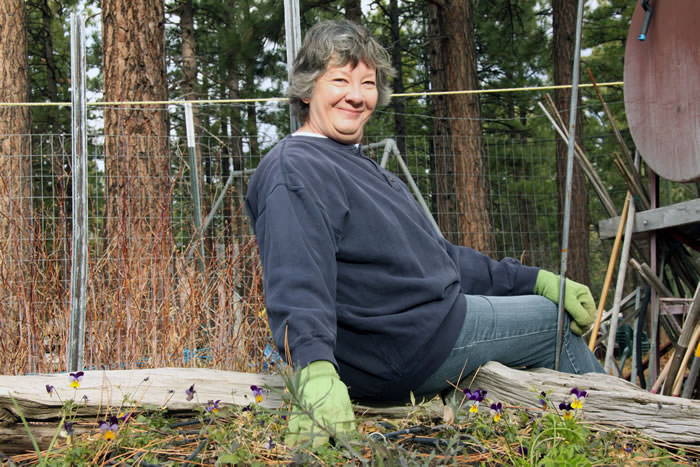edible garden
GOING WILD
Tips and tricks for gardeners who have disabilities.
WRITTEN AND PHOTOGRAPHED BY LESLIE JORDAN CLARY
Avid gardeners describe their passion with words such as healing, nurturing, and spiritual. For the gardener with physical disabilities, those words take on particular poignancy.
Gardening is healthy. It provides physical activity, is a great stress reducer, and gives us nutritious food for the table. But some people have physical limitations, which makes gardening difficult. Particularly as we age, our joints aren’t quite as flexible as they used to be, making lifting and bending painful. Arthritis, other illnesses, and injuries all can take their toll.
An enabled garden
Jean L. French from Janesville, Calif., has loved gardening since she was young, but in recent years, severe scoliosis, two hip surgeries, and a number of other skeletal problems have made mobility difficult. As a retired English professor at the College of Southern Nevada in Las Vegas and a writer — her most recent book of poetry, Watershed, will be released this May (Folded Word Press, Foldedword.com) — French found a way not only to tackle the garden issue, but also to combine her love of teaching, writing, and gardening into a blog — Garden, Forest, Field — where she shares tips for disabled gardeners, recipes, and personal glimpses into her gardening methods.
French says the most important thing she has learned as a disabled gardener is to “go wild.”
“You have to let go of perfections,” she says. “Especially as disabled gardeners, we need to adjust our ideas about gardens. People think a garden has to be weed free and perfectly orderly to be beautiful or productive. It doesn’t. The wilder a garden is, the easier it is to maintain.”
Instead of well-manicured plots with exotic plants, French encourages gardeners to nurture what already is growing.
“Don’t see weeds as the enemy because many are edible. Others are medicinal. Also, many wild plants are good for bees,” she says. “Purslane, dandelion, and miner’s lettuce all are common wild edible plants in the Reno-Tahoe area.”
French also suggests letting the plants “volunteer.” That is allowing vegetables that already have been planted to propagate on their own.
“I haven’t planted lettuce for years,” she says. “It just keeps coming back. Letting things go to seed and volunteer the next year, and year after year, is one of my strategies for disabled gardening. Learning to see the beauty in every flowering plant in the garden is another.”
Accessible areas
As well as changing our mindset, a number of practical steps can be taken to make a garden accessible for everyone. This can be seen at Reno’s Teglia’s Paradise Park Community Garden, where Michelle Hawkins is a volunteer coordinator.
“Our handicapped-accessible plots are raised about three feet off the ground, so people in wheelchairs can work at the right height,” Hawkins says. “Even if they’re not mobile, they can still take part in the garden.”
Hawkins says several of their regular gardeners are seniors, some with limited mobility.
“Most of them are retired, so they have more time to put into their gardens,” she says. “Some come from farming families, so for them it’s therapeutic to come and grow things.”
Other modifications to help make gardening easier include container gardens, hanging planters, and modified tools, as well as choosing plants that grow upward on trellises and creating wider paths for wheelchairs. Visually impaired gardeners will want to keep their plots close to the ground and choose plants that can be identified easily by scent or texture.
Both French and Hawkins agree that the primary benefits to continuing to garden as we age or if we become disabled are the mental clarity and peace of mind that working with plants brings. Disabled gardeners have special challenges, but the joys and rewards of working a garden make overcoming those challenges worth it.
As well as being a freelance writer, Leslie Jordan Clary is the owner and creator of Leafy Botanicals, which handcrafts organic, herbal-infused body care products to aid in pain relief of arthritis and muscle aches and pain.
RESOURCES
The following are some practical tools every disabled gardener will want to consider using:
A chair, or even a couple of chairs, situated around the garden area so you can sit to weed. These should be light and easy to move around.
A garden stool. This low stool has a padded seat cover and pouches for tools and gloves. It can be adjusted for height, rocks back and forth, and swivels so it’s easy to cover a fair amount of ground before needing to get up and move. It may not be for everyone as it’s not always easy to push yourself up, but a lot of people find it handy.
A garden kneeler. Garden kneelers sometimes are offered along with stools. Both stools and kneelers can be helpful for anyone with arthritis, varicose veins, or trouble standing. As an added bonus for anyone, it also can keep those grass stains off the knees of your pants.
A sliding hoe. French calls this a hula hoe. The blade slides along under the surface of the soil and slices the roots of weeds.
A wagon or roller tote for moving things around.
PVC pipe or old broom handles to extend hand tools, so you can work standing up.
A small jar with holes in the lid so you can sprinkle seeds from a standing position.


